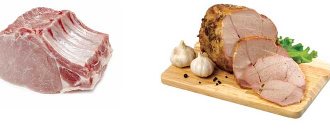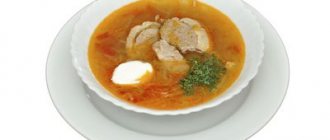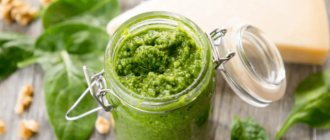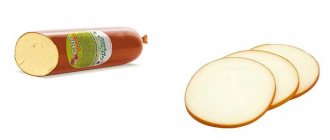About doctor's sausage:
Doctor's sausage was specially created for “sick people with poor health as a result of the Civil War and tsarist despotism.” The recipe for “improving public health” was verified to the smallest detail. 100 kilograms of sausage contained 25 kilograms of premium beef, 70 kilograms of lean pork, 3 kilograms of eggs and 2 kilograms of cow's milk. Nothing extra.
However, the war and post-war shortages took their toll again. The era of searching for various meat substitutes has begun, such as glycerin, albumin, gelatin, edible herbs and even tops of garden crops. They began to add peas, cereals, flour, onions and even boiled potatoes to the sausage. But even despite these additives, the quality level of doctor's sausage remained high until the mid-seventies.
Doctor's sausages and doctor's sausage had a high percentage of meat, and it was a meat cocktail that was adaptive to our digestive tract. But over the years, commercial meat production has made its own adjustments, and today doctor’s sausage does not resemble the product of those years at all.
It has nothing to do with meat at all.
In the 60s of the last century, an experimental era with fattening animals began all over the world, and the sausage smelled of fish, chickens, and a chemical plant producing fertilizers. And already in the seventies, GOSTs allowed the addition of soy protein, milk protein, including indigestible sodium caseinate, to sausage mince.
Let's look at what we ended up with. Today's regulations establish the quantity of necessary ingredients for the production of raw meat, and not meat in the classical sense. These can be tendons, connective tissues, that is, fat, food blood, crushed bones, meat film, offal. Also acceptable are the additions of soybean and gum - a substance of plant origin that has the ability to retain a lot of water. Carrageenan is very actively used today; when dry, it looks like a gray powder. This is an extract from red algae, a complex polysaccharide that attaches a lot of water molecules to itself and creates a tasteless and odorless gel. Its solubility varies. For the meat industry, as a rule, a thicker gel is used, which dissolves approximately one in thirty to forty. Then another important component is added, which is called animal protein.
Animal protein is, as a rule, slaughter waste dried and ground into dust: pig skins, cow udders and lips, cartilage of various animals and poultry. It should be noted that this is indeed protein, but it is difficult to digest.
What to do?
Experts advise: if you are an avid meat eater, you should try replacing sausage with baked or simply boiled meat. This cooking method allows you to remove excess fat from meat and endlessly experiment with spices. You can also replace sausage with boiled beef or chicken breasts. At the same time, the price of chicken breasts or turkey fillets is no more expensive than sausage, and they contain 7 times less fat than in “Doctorskaya”.
Or make doctor's sausage yourself. It is quite possible.
BZHU sausage cheese
Semi-soft smoked cheese in the form of a sausage loaf appeared in Russia in the mid-20th century and became firmly established in the diet.
Sausage cheese has a delicate texture and a bright, piquant smoked taste. An additional plus is a long shelf life.
Composition of the product:
- low-fat cheese for melting or cottage cheese;
- semi-hard cheese;
- powdered milk;
- butter;
- salt;
- spices;
- melting salts;
- water.
We recommend that you familiarize yourself with the BZHU of blueberries
The smoky flavor is imparted to the product by natural smoking or liquid smoke.
KBZHU smoked sausage cheese (100 g)
| Proteins, g | 18,3 |
| Fats, g | 18,6 |
| Carbohydrates, g | 5,38 |
| Calorie content, kcal | 259,12 |
Recipe? Recipe!
Is it possible to prepare doctor's sausage at home? Can! Here are two recipes:
Doctor's sausage:
- 1 kg beef
- 1 egg
- 3 tbsp. spoons of powdered milk
- 2 teaspoons salt
- 1 teaspoon sugar
- 1/2 teaspoon nutmeg
- 2 tbsp. spoons of liquid smoke
- 250 ml water
Mix all ingredients using a blender.
Place the minced meat tightly into the baking sleeve.
Secure the ends of the sleeves, place on a baking sheet and bake in the oven for 30 minutes.
Then transfer the sausage to the slow cooker and cook in the “Stew” mode for 1.5 hours.
Homemade doctor's sausage:
Since sausage can be prepared not only according to GOST, we suggest that you familiarize yourself with the recipe, which requires the use of minced pork. It may be similar to “Amateur” or “Doctoral”, and this quality is influenced by the grinding of the bacon. For example, to make “Lyubitelskaya” sausage, lard cut into pieces is added to the minced meat rather than twisted.
Sausage composition:
kilogram of pork; 300 grams of lard; onions (to taste); 2 cloves of garlic; one raw egg; a tablespoon of gelatin; 0.5 teaspoon black pepper; 1 tablespoon each of nutmeg, semolina, salt (without top) and sunflower oil.
First we prepare the minced meat. We thoroughly wash the meat, cut off all the films, veins and cut into pieces. Grind the pork with a blender along with garlic and onions to obtain a creamy mass. Another option for grinding meat is to use a meat grinder. And if you want to make ham doctor’s sausage, you can add larger pieces of pork (chicken) to the minced meat. Then add the egg and mix well. Pour in the spices: black pepper, semolina, nutmeg, salt, gelatin and sunflower oil. And mix everything again to evenly distribute the added ingredients.
If there is no special form for ham, then we use a baking sleeve. Or there is another original way - use a juice or milk box as a form. After all, homemade sausage can be cooked without special equipment. We put the minced meat into a bag (sleeve), roll it up and tie it in several places with a rope (twin) so that the sausage becomes tight. You need to cook it for 2 hours after boiling over low heat. The water should boil slightly. And the amount of water needed is such that the bag of minced meat is completely covered.
Application
Doctor's boiled sausage is an excellent appetizer on the holiday table, suitable for making sandwiches, sandwiches, and canapés. In addition, doctor's sausage is one of the ingredients in many salads, omelets, pizza, casseroles, and cold soups. Fried sausage slices go well with vegetable salads, herbs and any side dish.
Market Analytics
- Global cosmetics market 2021: an unprecedented test for the global cosmetics industry
- Top 10 Cosmetic Research and Development of 2021
- 2020 in the beauty industry – innovation without borders
Convenient search for beauty salons on our website
Beauty salons in Moscow Beauty salons in St. Petersburg Beauty salons in Ekaterinburg Beauty salons in Novosibirsk
Latest blog posts on our website
- Naturecream / Properties of the “Sunny” oil itself
- Naturecream / “Sugar” wrinkles - or what glycation can do
- Naturecream / Esterified oils
- Naturecream / Arnica - the magical plant of alchemists
- Naturecream / Tremella Extract - Snow Mushroom Detox for Skin
- Prostye-sovety / How to visually enlarge your lips with makeup
- Naturecream / Apricot kernel oil for face
- Naturecream / MATRIXYL3000 - the best skin elasticity stimulator
- Naturecream / SPF in Natural Oils
- Naturecream / Geranium (Pelargonium) oil for skin health and beauty
Latest forum topics on our website
- Natalya / How to properly make a gelatin mask?
- Mrs._Smith / Badly sunburned! What to do?((
- Ice / Is it necessary to combine fitness classes with a diet?
- Antonova / What can be used for hair loss?
- Radio operatorKat / Who was on a protein diet?
Other articles in this section
| Boiled milk sausage Boiled milk sausage is a type of boiled sausage with a unique recipe and special cooking technology. The name of the sausage is due to the fact that, in addition to the main ingredients, its composition includes milk, and specially selected spices give the finished product its taste and aroma. |
| Dry-cured chorizo sausage Chorizo sausage (chorizo) is a dry-cured variety of sausage, with a spicy, pronounced meaty taste and aroma, a specific rusty-red color, prepared from fresh minced pork according to a special recipe in Spain. It is worth noting that chorizo is a fairly popular snack not only in Spain, but also in Portugal, as well as in Latin American countries. |
| Cooked-smoked amateur sausage Cooked-smoked amateur sausage is a product with high taste value, which has been in great demand among consumers for many years. This sausage is prepared as follows: minced beef is mixed with spices, pork lard, cut into small pieces, is added to it. Then black hot and allspice peppers and garlic are added to the mixture. After this, a special sausage casing is stuffed with a mixture of minced meat. The casing is tied at the ends with twine, pierced to remove excess air, and the sausage is smoked using hot smoke. After the sausage becomes firmer, the cooking process begins. Boil it in water at a temperature of about 75 degrees for an hour. After cooling, the sausage goes through a secondary smoking stage. The finished product is stored in the refrigerator, shelf life is no more than 2 weeks. |
| Salami Salami is a dry-cured meat product with a lot of spices. Italy is officially recognized as the birthplace of salami, although there are versions about the Greek origin of the product. This is because during archaeological excavations in the ancient Greek city of Salamis, a recipe for making sausage was found. Salami appeared on Russian tables during the time of Peter the Great. |
| Poltava semi-smoked sausage Poltava semi-smoked sausage has a dense structure, the slices of pork belly are clearly visible when cut. The sausage is quite tender and juicy due to the addition of pork and large pieces of lard. This variety is characterized by a moderately salty, slightly islandy taste. The sausage has a pleasant aroma of spices and garlic, with a slight aroma of smoke. This variety belongs to category “B” according to GOST. |
| Milk sausages Back in the 19th century, Austria and Germany were the first to come up with a new meat dish - milk sausages. When making this type of food, any meat (beef, pork, poultry) is taken, crushed and boiled, adding milk powder. Some manufacturers replace natural raw materials - meat with products containing vegetable protein or meat substitute. Natural sausages are smooth and elastic, pale pink in color. |
| Semi-smoked snack bar sausage Semi-smoked snack bar sausage is a heat-processed food product in the form of minced meat, packaged in an elongated casing. |
| Dry-cured sausage sudzhuk Sudzhuk is a hard, dry sausage. This product is in great demand in countries such as Turkey, Serbia, Croatia, Greece, Georgia, Kyrgyzstan, Armenia, etc. |
| Semi-smoked Odessa sausage Semi-smoked Odessa sausage is one of the types of first-class natural sausages. This type of sausage owes its name to the fact that the product recipe was first developed in Odessa. Odessa sausage is characterized by its high fat content and high nutritional value. |
| Amateur semi-smoked salami sausage Smoked salami sausage is of Italian origin. It usually includes beef, pork, various spices, seasonings, as well as various types of wines. First, the meat is salted, at the same stage seasonings are added, after which it is sent to dry in special conditions for several months. In 2-3 months, while it reaches the state of readiness, the casing of this sausage becomes covered with a thin layer of mold. It is she who says that the product is of excellent quality. |
Calorie content of boiled-smoked sausages
Due to the cooking technology, boiled-smoked sausages contain significantly more calories. During the preparation process, it is first boiled and then smoked. Typically, this type of sausage contains more spices, and other ingredients may include flour, milk, starch and cream.
Also, the calorie content of sausage depends on the composition of the minced meat - boiled-smoked sausages can contain not only homogeneous minced meat, but also pieces of meat of a certain size.
The shelf life of this type of sausage is slightly longer and averages 15 days. The calorie content of sausage is also higher, for example:
- Amateur – 420 kcal;
- Cervelat – 461 kcal.
Calorie content of smoked sausages
The modern food industry produces a huge number of smoked sausages of various types. A wide range of these products pleases consumers - on store shelves there are sausages for every taste. The older generation could not even dream of such a variety that is offered to us now.
However, is this product so good in terms of health and nutritional value? Let's start with the fact that the calorie content of smoked sausages is very high. This is not a dietary product at all and is not recommended for people with increased body weight.
Smoked sausages are divided into:
The average caloric value of boiled-smoked sausages is 450-480 kcal per 100 g of finished product. At the same time, they contain a large amount of fat (up to 40%) and about 35% protein. For a more detailed analysis of the calorie content of smoked sausages, we present the average values for the most popular types of boiled smoked sausages (per 100 g):
- Boiled-smoked sausage “Moskovskaya” - 402-408 kcal;
- Boiled-smoked sausage “Tallinnskaya” - 375-379 kcal;
- Calorie content of Servelat sausage is 406-425 kcal;
- Boiled-smoked sausage “Odesskaya” - 402-407 kcal.
The calorie content of raw smoked sausages varies widely - from 320 to 500 kcal/100 g. The most popular variety of raw smoked sausage “Braunschweig” contains 488 kcal/100 g, and the calorie content of “Moscow raw smoked” sausage is 420-450 kcal/100 g. Less caloric is a “Grainy” sausage – its calorie content does not exceed 350 kcal/100 g.
The calorie content of semi-smoked sausages is practically no different from the calorie content of other types of smoked sausages. The average value is 450-520 kcal per 100 g of finished product, however, this value may vary depending on the region of production and the specifications (technical conditions) in force at the manufacturer’s enterprise.







